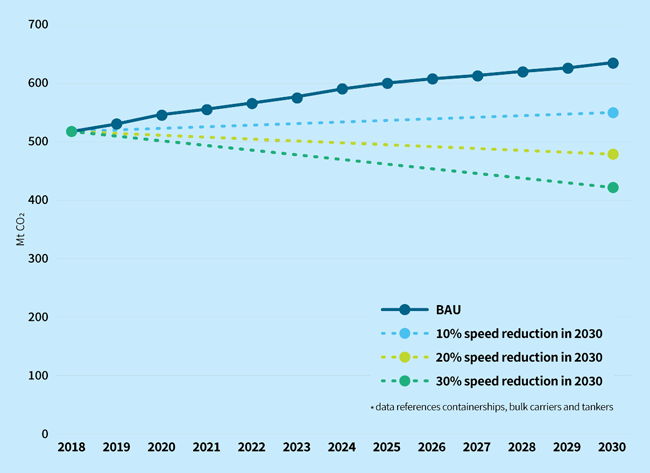Reducing the speed of three main ship types by 30 per cent could decrease annual CO2 emissions by nearly 200 million tonnes.
Emissions of the main greenhouse gas carbon dioxide (CO2) from three ship types – container ships, bulkers and tankers – could be reduced by a third, on average, by reducing their speed, according to a new study that was presented to the International Maritime Organization (IMO) in October.
The cumulative emission savings from 2018 to 2030 from reducing the speed of these ships alone, would amount to around 2.5 gigatonnes – equalling as much as 12 per cent of shipping’s total remaining carbon budget if the world is to remain below 1.5°C global temperature rise, according to environmental groups Seas At Risk and Transport & Environment, who commissioned the study from CE Delft.
Ship speed can be regulated either globally, unilaterally as a condition of entry into a port or as a condition to navigate in coastal waters, or bilaterally between ports in two states. The study concludes that in order to effectively reduce emissions, speed regulations should be mandatory and accompanied by an enforcement system that deters ships from not complying. Speed regulations should best be differentiated by ship type and size so that ships do not have to operate at technically challenging low loads and to avoid interfering with competition between ship types.
As slow steaming may have impacts on the competitiveness of countries that are far away from their main markets, the study analysed two cases of exports from South America to the EU. Even with very conservative assumptions, the impacts are modest – export values could be reduced by a few tenths of a per cent at most, and the overall economic impact would be well below a tenth of a per cent for the whole of South America. Such impacts do not take account of the significant cost savings that accrue from reducing speed and burning less fuel, meaning that any speed regulation will likely provide a net financial benefit.
Moreover, reducing operational speed would provide a boost to jobs and growth in shipbuilding nations, where production would have to grow by over 30 per cent in order to maintain transport capacity for global trade.
The three ship types analysed jointly account for more than half of global shipping’s carbon footprint. Substantial additional savings will be made if the speed of the remainder of the fleet is also reduced.
At the meeting of the IMO’s Working Group on greenhouse gases in October, calls for urgent action to reduce ships’ emissions were met with resistance from many states and big industry groups. A group of Pacific Island and mainly European states clashed repeatedly with those saying that decisions on immediate measures should await the final iteration of the IMO’s comprehensive greenhouse gas strategy in 2023, rather than be part of the initial strategy in 2018.
Environmental organisations concluded that operational speed reduction is the only measure on the table that can deliver the substantial and immediate short-term emissions reductions that the Paris agreement demands.
John Maggs, senior policy advisor at Seas At Risk and president of the Clean Shipping Coalition, said: “Can a strategy that doesn’t prioritise emissions reductions in the next six years be considered ‘comprehensive’ or indeed fit for the urgent purpose of tackling the climate crisis? We don’t think so. The IMO meeting heard that ship greenhouse gas emissions are rising again and need to peak soon, but key flag states and developing countries blocked an agreement to prioritise and develop measures for immediate short-term emission reductions.”
The initial IMO greenhouse gas strategy is due to be finalised in April 2018.
Christer Ågren
Source: T&E News, 18 and 30 October 2017.
The report “Regulating speed: a short-term measure to reduce maritime GHG emissions” (October 2017) by J Faber, T Huigen and D Nelissen. CE Delft (www.cedelft.eu).
 Figure: Global CO2 emissions up to 2030 from container ships, bulkers and tankers under the business-as-usual scenario (BAU) scenario and under three different speed regimes.
Figure: Global CO2 emissions up to 2030 from container ships, bulkers and tankers under the business-as-usual scenario (BAU) scenario and under three different speed regimes.
Table: Average annual CO2 emission savings in the period 2018–2030 (million tonnes)
| Speed reduction | |||
| 10% | 20% | 30% | |
| Container fleet | 34 | 62 | 85 |
| Dry bulk fleet | 32 | 59 | 83 |
| Crude & product tanker fleet | 10 | 19 | 25 |
| Total | 76 | 140 | 193 |































